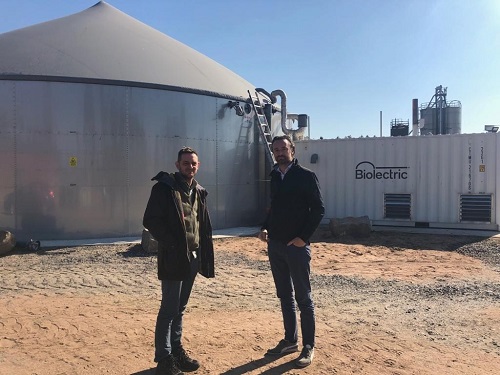Cattle farming contributes to the climate change, because cattle emit methane gas (CH4). Biolectric’s innovative installations convert this harmful greenhouse gas by converting it into green energy and are therefore an effective weapon in the fight against global warming.
In the debate on climate change, the effects of carbon dioxide are generally the central topic of discussion, but the impact of methane is actually 20 times larger than that of CO2. In that sense, cattle are major polluters, as their droppings produce a lot of methane. The biogas installations or digesters of Biolectric, a company from Temse in East Flanders, however, make it possible to use the dung as a resource for sustainable energy, in a relatively accessible way.
Biogas installations as such are not new in the agricultural sector, but until now they have been primarily used on corn or organic waste that often had to be cultivated and transported to the farm. “Manure, on the other hand, is a waste product that otherwise doesn’t have any value in the food chain and that is also produced at the site of the farms itself,” explains Biolectric CEO Philippe Jans.
The compact Biolectric installation consists of a container and a silo in which dung is collected and the methane processed. It can be set up in just a few days and immediately starts providing electricity – much more quickly than classic biogas installations. The technology can reduce the methane emission of cattle farms by about 70%.
Efficient and cheap
A big advantage of manure as a sustainable resource is that it doesn’t depend on the unpredictable elements of nature, as solar and wind energy do. A Polish government study also indicates that it is the cheapest way to generate green energy and reduce the amount of greenhouse gases in the atmosphere.
“We cannot expect everyone to stop eating meat and consuming dairy products to save the climate. That is also less necessary thanks to our solution, as we can considerably reduce the ecological footprint of the agricultural sector,” says Jans.
With a digester, a farm can provide for its electricity and heat needs and often on top of that sell energy to the grid. This way, a cattle farmer can already earn back their investment in, on average, six to seven years. Biolectric offers six types of installations, the smallest of which costs about 100,000 euros and the largest approximately 350,000 euros.
Larger digesters are more easily profitable, but Biolectric is consciously targeting the wider market, to make this method viable for almost any cattle farmer. Interested farms should ideally possess at least 60 cows, which is the case for the majority of cattle farms in Flanders.
Increase production
Biolectric not only targets farms with cattle but also has innovations in the pipeline for the methane in pig and chicken manure, sewage and animal waste produced in slaughterhouses. The enterprise is also pushing its boundaries geographically: it’s not only active in an increasing number of European countries but is also taking its first steps on the North American market.
With the recently acquired support of Ackermans & van Haaren, which became a shareholder at the start of the year, Biolectric wants to increase its production of biogas installations in five years from 50 to 250 a year. To date, the firm has set up about 210 digesters at clients worldwide.
Raising awareness
Jans doesn’t count on financial support from the government for Biolectric’s further expansion, but does feel the government should focus more on raising awareness around sustainability when awarding permits to cattle farmers.
“Unfortunately, cattle farmers are still too often inclined to only invest in the expansion of their livestock, instead of considering more sustainable action,” says Jans. “We offer them the option to remain profitable with a limited number of cows, which is good for them but also for the environment. Since the agricultural sector is also affected by global warming, this can only be to their benefit as well.”


